Salmon fly below the surface
Above: The artificial wet-fly icon: The Jock Scott – allegedly conceived by the ghillie Jock Scott – on his way to Norway accompanying his employer Lord Scott. Here is a 6/0 version from the hands of the fly-tying company: Redpath Kelso-on-tweed. Such big single-iron flies were used by British anglers in the early season as late as the 1940s when tube flies replaced them, and later again, big Waddington shanks.
Sometimes surface fishing is the ideal choice. One will be able to out-fish all other anglers by dead-drifting a small Bomber dry fly or trailing a tiny riffling hitch tube fly as opposed to using a subsurface salmon fly technique – But more often, it is the angler using the conventional wet salmon fly that will have the best chance of catching the fish of the day.
Salmon fly – sub or surface ? Even though it isn’t all that obvious… surface and wet-fly fishing is worlds apart.
10 inches below could be the prime depth for summer fishing
10 inches below the surface, is a well-established guideline for the depth to fish a conventional salmon fly during summer. This is the type of fishing most anglers expect to fish and buy fly fishing gear to fish – This depth could be achieved by using a full floating line, a salmon fly tied on a single, treble or double iron, and a 9 – 10 foot leader – Add a medium or big river in summer conditions with a fair flow of + 9 degrees Celcius water (48,5 Fahrenheit), and that should bring the fly close to the desired depth of 10 inches below.
This is not always the case and the setup as described before will probably get you somewhere between the surface and 10 inches below – and sometimes you may have to look for the fish a bit deeper
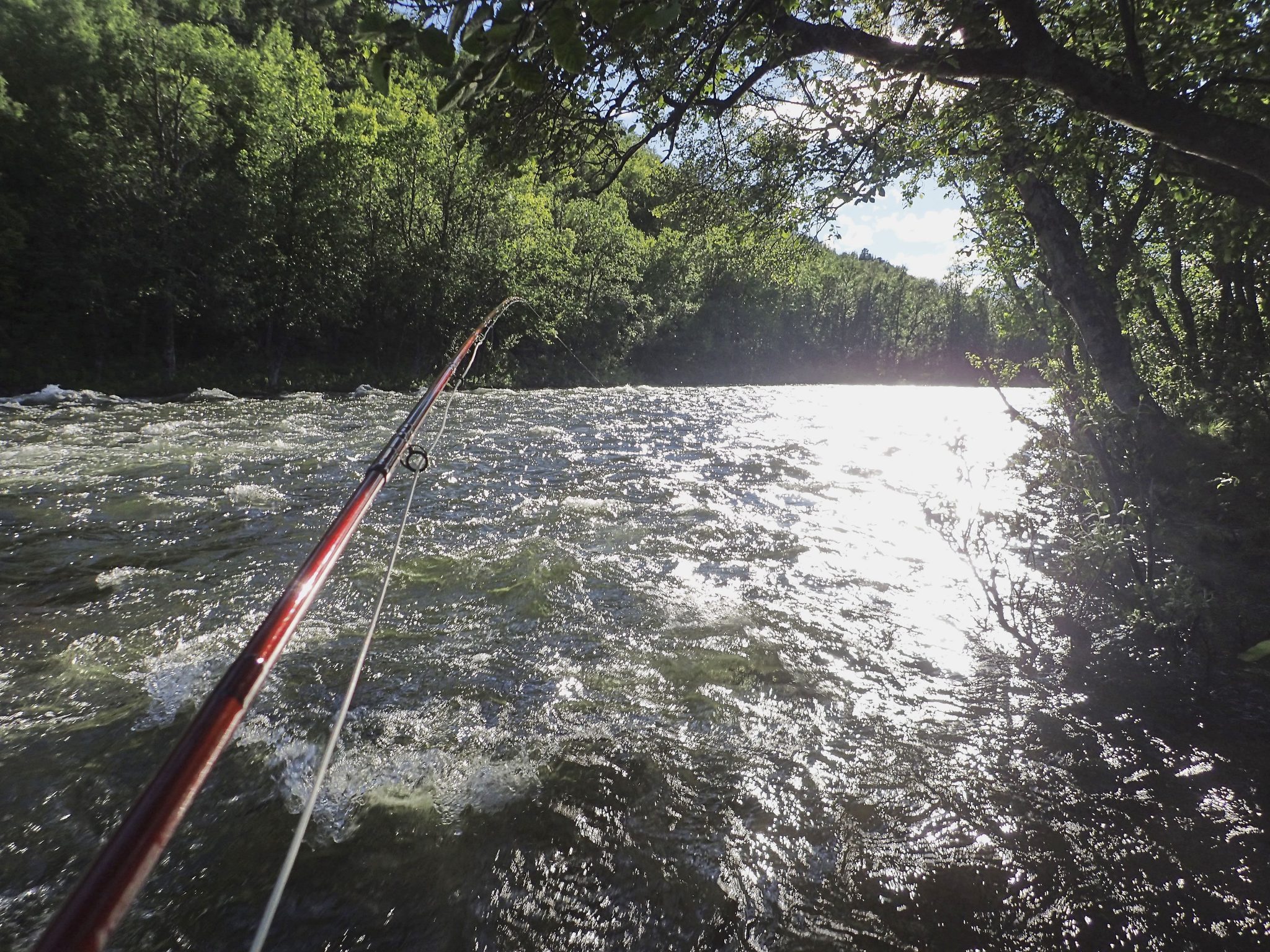
10 inches below the surface – is not always the case – More often the fly will be in the area between the surface and 10 inches below
Guidelines for the use of various sub surface fly fishing techniques
To be truly successful throughout the season anglers may have to fish for salmon and steelhead in different places in the water column – Numerous manuals have been written on this intriguing subject and this could very well be yet another set of guidelines – so before I start I would like to make a few notes on details in salmon fishing that may have a great influence on your choice of fly line and flies this will not be a fixed manual but a set of guidelines based on experiences I have had over the years with river height the temperature in the water water flow and how all this may progress during the season.
Depth of the river
Depth of the river – The river depth is of great significance when you chose the sinking rate of fly line and flies especially in those cold months in the beginning and at the end of the salmon season where the fly must be presented at specific lies at a specific depth – But sinking lines are not always necessary – even in extremely cold June – July rivers ( 1 – 2 degrees Celcius 33 – 35 degrees Fahrenheit) salmon may come to the surface and snatch a fly in a low river (1 – 2 meter 3- 6 foot deep) and I have friends that never would think of changing their trusted floating line that they used to the end of the season the previous year.
Even in a extremely cold June – July river Atlantic salmon may come to the surface and snatch a fly
At the same river and time, other anglers may use sinking lines of various densities and unmistakably also hook up with salmon – it goes to show that fresh running salmon are active hunters with great stamina and appetite that can move a lot in high waters – in fact, it could be highly beneficial to have more than one setup of equipment ready in times of high water.
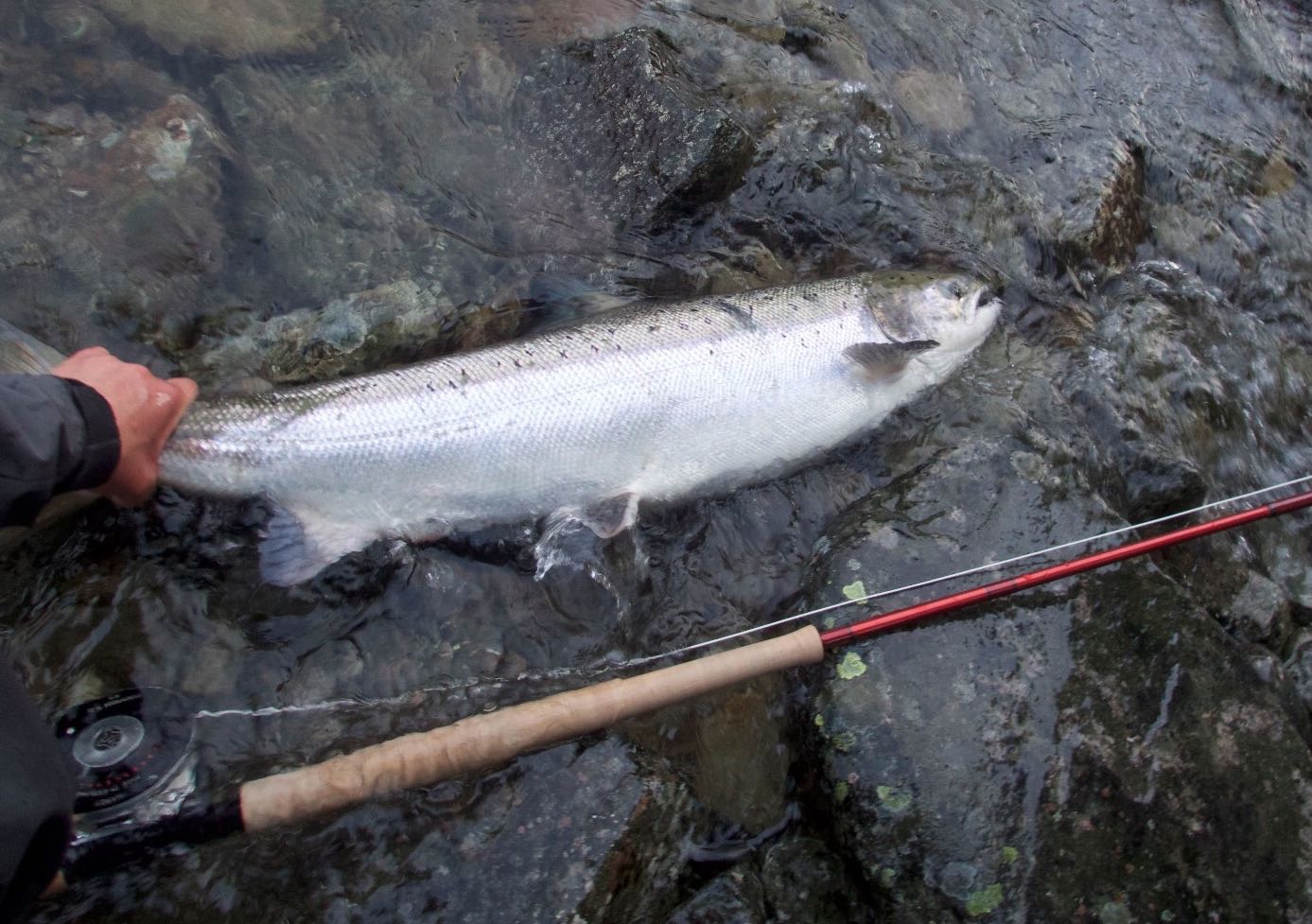
Big + 90 centimetres (+ 36 inches) salmon caught in 2 degrees Celcius ( 35,6 Fahrenheit) water on a full floating line – in an extremely turbulent part of a shallow river – Shallow rivers don’t always dictate sinking lines even though the water temperature is low
Late salmon fishing
Late-season fishing in low-water rivers with a mixture of dark and silver fish can make a fascinating sport and is also one of the most demanding forms of river fishing anglers can participate in. Fish can be extremely picky, and anglers would have to spend time by the river to learn the ways of the fish. The low water narrows down the area where the fish can see the fly, and precise presentation and tiny details in flies are the names of the game.
Caught on a dwarf, Frances fly – An excellent fly for tricky presentation
Late season fishing in low water rivers: Even a small change in the depth the fly is fished can be of great importance
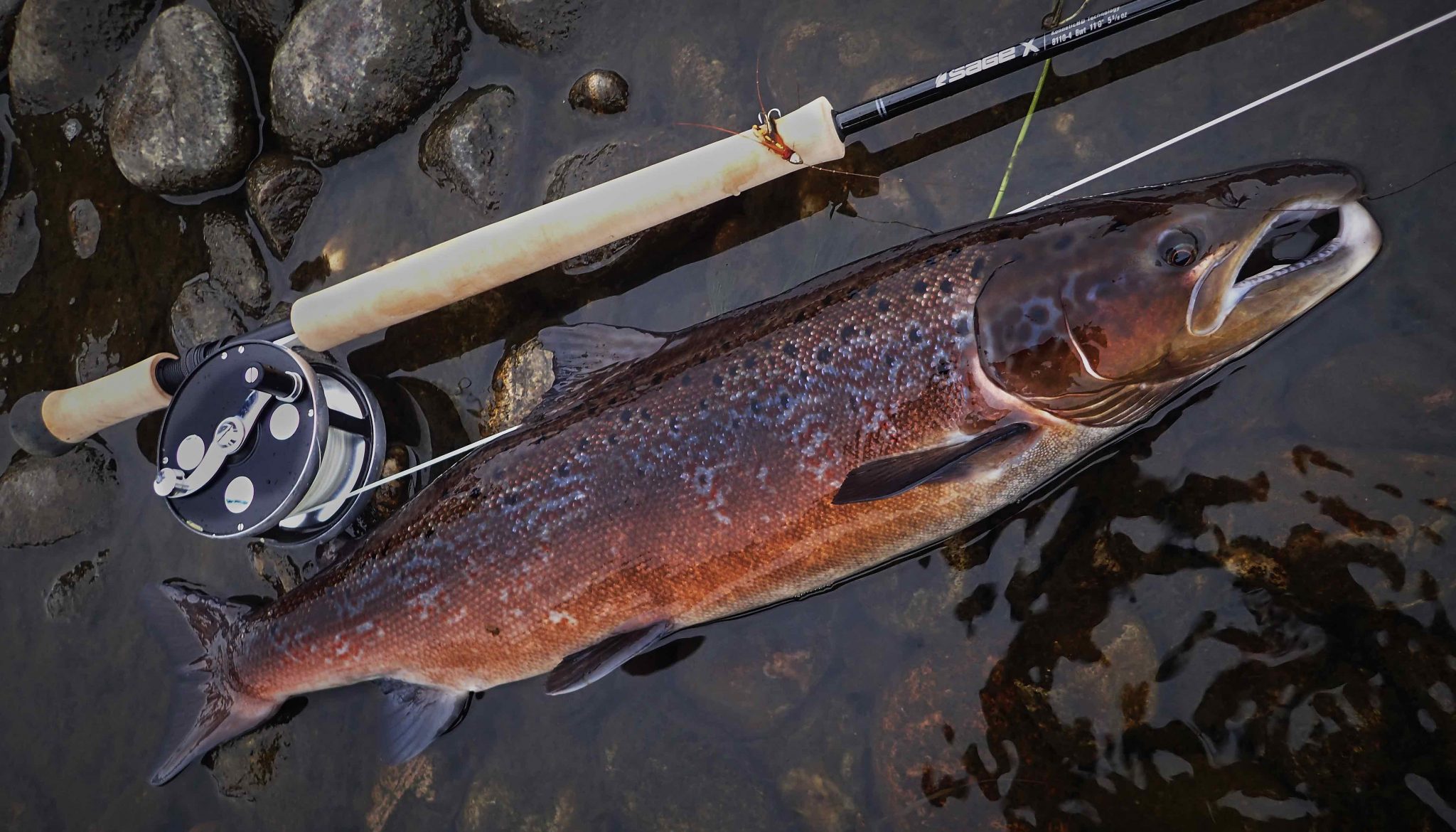
Salmon from October – caught in a shallow Scottish river – In the late end of the season temperatures can drop to a few degrees Celsius (35 – 36 degrees Fahrenheit) and even a tiny change in the depth the fly is fished can be of great importance – Use different density sinking poly leaders to find the right depth – Here I used a floating line and a 10 foot super fast sinking leader
Early salmon fishing
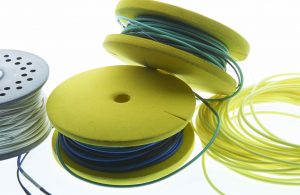
Photo: I prefer to use full lines for my riffling hitch and dry fly fishing – but I consequently use shotting head systems when I fish sunken lines and high water early in the season – The ability to change lines fast and easily during my fishing is second to none with the shooting head system.
It is not known exactly why the Atlantic salmon prefer bigger flies in the very early part of the season – and then smaller flies as the water temperature rises
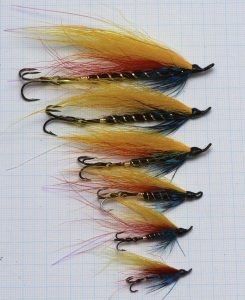
Photo: Various sizes of Garry flies tied on Waddington shank – biggest is 80 millimetres + 3 inches. Favoured flies for early season fishing – or when the river is in a spate
The right salmon fly
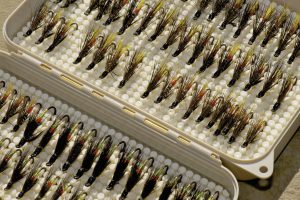
Getting the right salmon fly for your fishing is certainly an axis point in the world of salmon and steelhead fishing – so obviously, it is well worth spending time & money on making or buying the ultimate flies. Generally, one can look upon the salmon fly as a miniature aeroplane or, rather, a submarine. The fly’s ability to manoeuvre and finally deceive the fish will very much depend upon or be determined by the river you 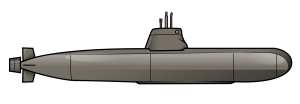
Making the perfect illusion
Deceiving a salmon into taking a fly is directly comparable to a magician making the perfect illusion – Use your mind to imagine how your fly is looking at the end of the leader – this could help you succeed

If you’re using a conventional wet salmon fly, you will have to sell the whole package to convince the salmon or trout to bite the hook. It could be small details in the fly – the way you fish the fly – or the way the fly is moved by the currents that could be the thing that catches the attention of the fish – but it all has to come together as one unit at the end – and that is not always easy.
Salmon flies during the season
Every river I have fished has had its own set of salmon flies or at least some unique salmon flies designed for that particular river – This only shows that details matter. Not only colours and specific fly-tying material but also the overall design or styling of the fly vary from river to river – something that often is coupled with the river’s specific flow and the particular part of the season you visit the river.
It is always worth listening to the local guys or the shopkeeper in the local fishing tackle shop, to learn what kind of flies go well in the river you have come to fish.
There is some guiding principle on flies. Here are a few important ones
- Clear rivers – Lightly coloured flies grey/black/White/blue/green
- Dark-coloured water – Darker-coloured flies Orange/Red/Yellow/black
Cold water bigger flies – Warmer water, smaller flies
- From 1 – 4 degrees Celcius ( 33 – 40 degrees Fahrenheit), 4 – 3 inches flies
- From 6 – 9 degrees C. (42 – 48 2 degrees F.) 2 1/4 – 2 inches. flies
- From 10 – 18 degrees C (50 – 56 degrees F.) 1 3/4 – Minature flies
- From 12 degrees C. (53 degrees F.) Dry flies and hitch flies become very effective –
- At 18 degrees C. (56 degrees F.) Dry fly becomes the prime fly in many rivers.
- At – 21 – 23 degrees C. (70 – 73 degrees F.) salmon fly fishing becomes tough, to say the least – and flies are best presented early in the morning and in places where the fish lies in the shade throughout the day.
There is no doubt that consumption of larger bait fish at sea is part of the overall success of big salmon in rivers across the Nothern Hemepsfere – but their love for bigger bait could also tie in with their love for bigger flies
Big fish prefer a relatively big fly -
A bold statement – and this is not the whole truth as big fish also get caught on very small flies and everything in between – but it is a fact that many big salmon are caught on bigger flies. One could think that this was a case of anglers thinking; big fish – big chunks of food and therefore generally used big flies on big fish … but ask the seasoned local angler on a Norwegian river what he would tie on if a bigger fish entered the pool – He or she would know that the bigger fish have a weakness for bigger flies and would quickly change the # 12 to a # 6 – # 4 or even a size 2 – 1
We can only guess why this is the case – and my guess would follow some of the facts we see in surveys done on The food Atlantic salmon feed on at sea – There is no doubt that consumption of larger bait fish at sea is part of the overall success of big salmon in rivers across the Nothern Hemisphere – but their love for bigger bait could also tie in with their passion for bigger flies

Sea-liced Atlantic salmon fresh from the tide caught on a 2 1/4 inch black & Blue tube fly. Bigger salmon love bigger flies, and most skilled anglers I know have a larger fly ready for the bigger fish – should it suddenly arrive in the pool.
The fly with a long wing
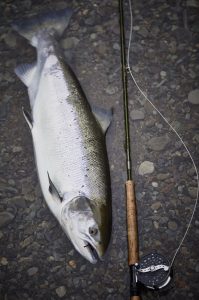
When fresh fish is moving fast – it can be well worth the effort to speed up the salmon fly by pulling in line – as fast as you can!
Do the fish see the fly as food or as an intruder? That is not always obvious but as the season progress your choice of salmon fly and tactics might have to change profoundly.
Different flies for different fish
Fresh fish are an “easy” catch and it is often this type of salmon that anglers tie flies to catch.
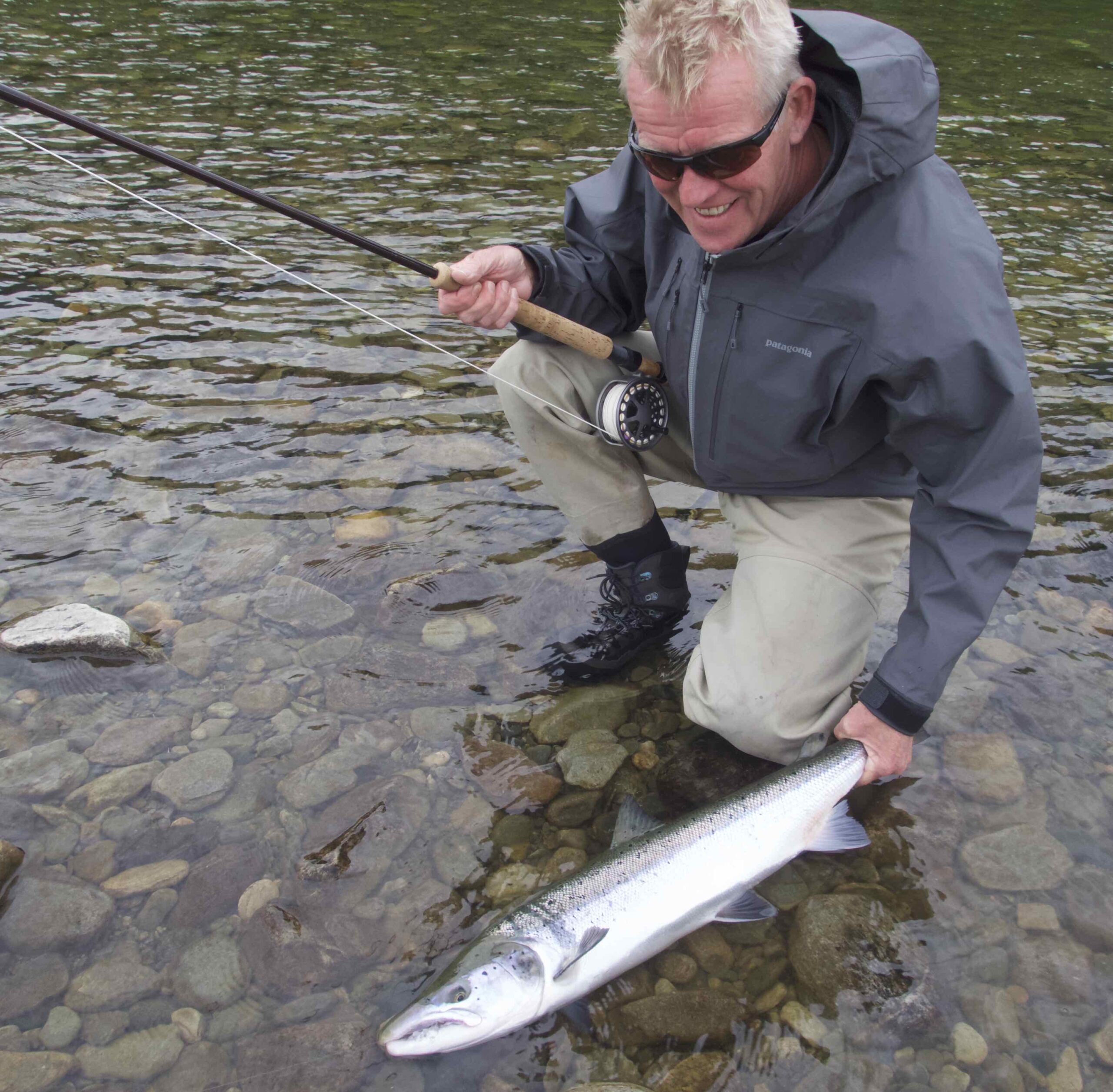
Fresh, curious, aggressive like this male salmon, is the fish we frequently connect with – but the river holds fish in many stages of life. Some will never touch your fly – others may only be fishable for a few minutes during the day. Salmon fly fishing gets interesting when you find the right flies and fishing methods for all these “different” fish.
 The resident fish
The resident fish
The resident fish is the fish that has been in the river for some time – that has lost some of its aggressiveness – It has travelled through pools and rapids – it might even have been out in the estuary again. It could also be a fish that has settled in a holding pool. That is starting to take colour. Who will jump when new fish enter his pool and occasionally rise to the trail of drifting insects… This is a fish well in tune with the surrounding environment, and it will take a special salmon fly to hook him – A fly that will work just right in that specific area – The local guy who comes to fish this spot…might have just that salmon fly in his box. Most likely, it will be a small neutral looking fly that in pose resembles some of the aquatic life the fish may encounter through the long days of waiting.
Stale fish, like the fish in the photo, is the salmon most anglers will meet when they visit the river during summer and early autumn – They are hard to catch. Still, the observant angler may notice that these fish have various levels of attention span where they act differently and may bite a fly. It could be when early morning slides into a sunny day – In the last hours of light – When new fish enter the pool and their patch. Small sub-flies that drift towards them like an insect – A small heavy fly that suddenly appears and rise to the surface near their patch – can result in a bite. This particular fish was caught on a Micro Conehead Frances tube fly # 16
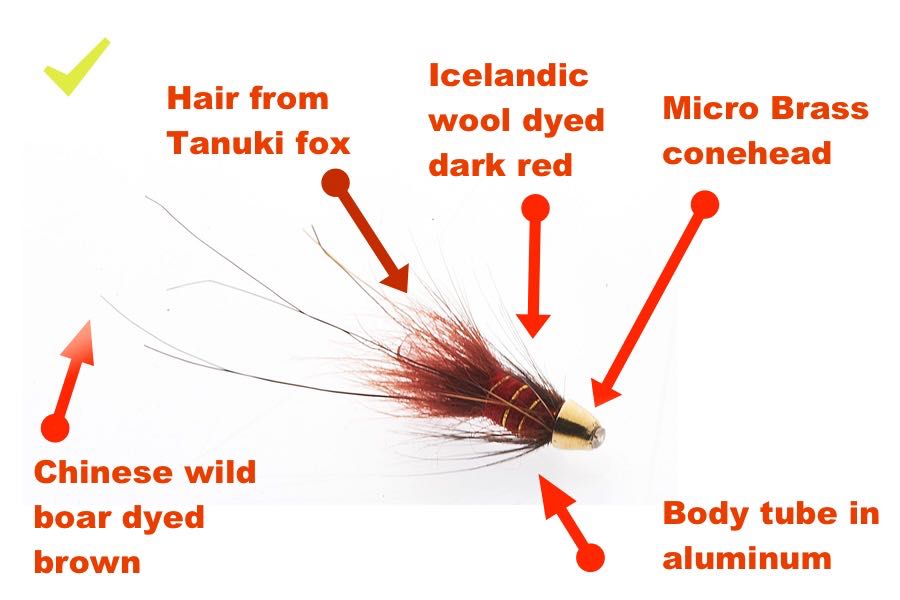
an excellent fly – This version of the Frances fly tied on a small aluminium tube. Fitted with a small brass conehead is an outstanding salmon fly. All the details come together in this fly that fishes at its best when presented drifting towards the fish, ultimately to be lifted in the last second. .
Another resident fish I spent an entire June day to catch – It was occasionally feeding – on something – not visible to me – It had looked and refused my tiny Frances fly several times, but after hours of casting and presentation, it suddenly took the fly – like it was the first time it had ever seen a fly.
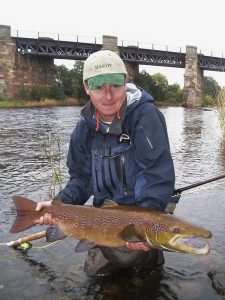
Photo: Pure Uncut Resident Evil: One aggressive male salmon from The Viaduct Pool at the North Esk in Scotland… A fish that probably had been in the river – and maybe in this particular pool all summer. It has most likely seen 101` salmon fly and know every rock in the pool – A truly formidable animal and one of the strongest freshwater fish you can catch on a fly rod. This one hooked on a tiny 10-millimetre Black & Orange tied on a copper tube, fished on an intermediate line, and a super-fast sinking leader – If you want to target these “crocodiles” it is worth fishing close to the bottom and to the middle bit of the river – Aggressive male fish like this one take up residence in classical pools at those classical spots where you would expect him to be.
Some flies work better during the end of the season
There is no doubt that special fly patterns become more efficient during the season – This could vary from river to river, but a fly like the General Practitioner seems to have an increasing effect on late-running salmon in Norwegian rivers
Here a big male August salmon, hooked on a General Practitioner – A super salmon fly for late fish especially multi-sea winter salmon like this one.
Fish & shrimps is on the menu
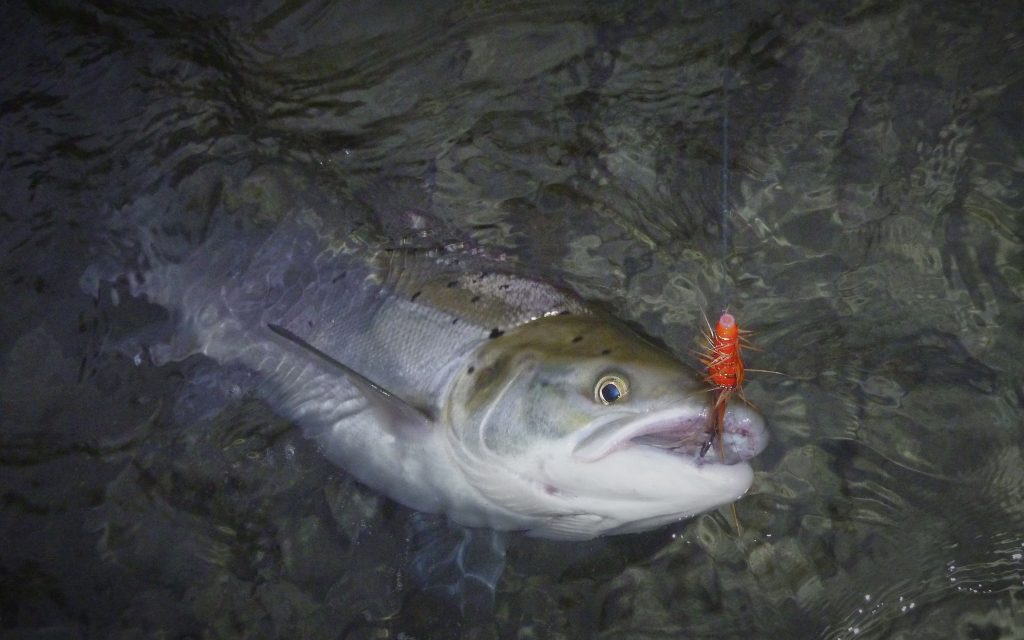
Revealing studies
Interesting studies into salmon feeding at high seas in the Northeast Atlantic by; biologists Jacobsen, J. A., and Hansen, L. P. show that shrimps accounted for 95% of the food in number but only about 30% by weight, 66% of the stomach content was fish, particularly mesopelagic fish. Some larger pelagic fish such as herring, blue whiting, and mackerel were also part of the dies. Fish and crustacean prey accounted for 96% of the weight of all prey taken by salmon, but the report also mentions a small percentage of Birds and bird remains to have been part of the salmon stomach content!!

Prawn and shrimp flies
Salmon and steelhead feeding habits and preference for prey have probably evolved through millions of years. Some of these – taste for foods – can be seen in using salmon flies along our rivers.
It is well-known that a prawn salmon fly pattern like the General Practitioner flies works much better in some rivers than others.
The British salmon, particularly the Irish salmon, seem to be more interested in prawn flies. More so than salmon in some regions of Scandinavia … Saying this, I recognize that it is hard to say if most of our sub-flies are interpreted by salmon as prawns and shrimps. We, as fly tiers, work unpremeditated with the prawn theme all the time.
Above: The Pandalus Borealis or the North Sea Prawn as it is commonly known – This crustacean embodies the red prawn flies we passionately like to tie – but the North Sea Prawn is probably just one of many crustaceans that the salmon will eat at sea.
The studies by biologists Jacobsen, J. A., and Hansen, L. P (see link from earlier) show that the salmon food primarily consists of much smaller and less flashy crustaceans than the Pandalus Borealis. Read more about the Pandalus Borealis.

Above: The GP or General Practitioner – another icon in the world of salmon fly fishing – Perhaps most of our sub-flies are interpreted by salmon as prawns… and we, as fly tiers, work unpremeditated with the prawn theme all the time.
Presentation, presentation and presentation
Flies is not everything – I have friends who give little attention to flies and place reliance on their ability to present the fly in such a way that the fish will bite – I believe it is a matter of both.
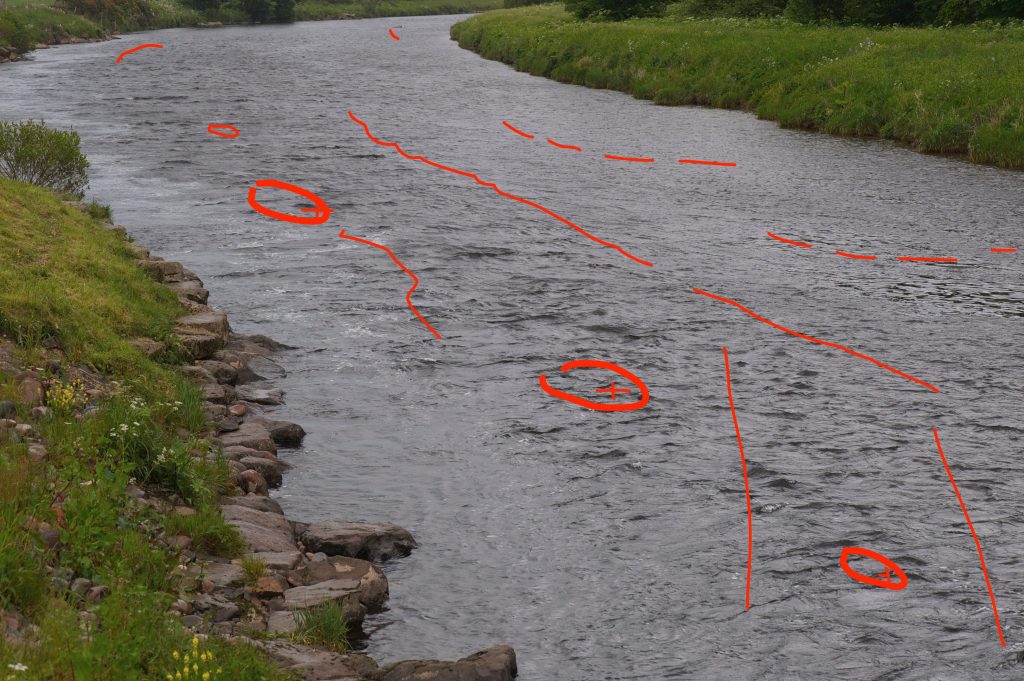
Fishing for salmon and steelhead is a matter of presentation – much more so than the actual fly pattern. The right salmon fly doesn’t do the trick alone – and the angler has to develop a long line of skills to be successful throughout the season.
Orthodox salmon fly fishing is often explained as; Cast across on a 45 ° angle – and then fish the fly to your bank – Take a step and a new cast... But fishing with a sub salmon fly is so much more – and to be truly successful in this sport – the angler – the fly and the river have to become one.
Above: Fishing for salmon and steelhead is very much a matter of presentation – in time, you will learn how to present the fly near those spots where fish are lying. The design of the fly, coupled with the presentation, should come into one and complete the deception.
A dedicated surface hunter
Now that you have read a great deal about wet-fly fishing I thought it was appropriate to end this page with a link to the surface – because although salmon could be caught deep in the river every day of the season – The same Atlantic salmon could come right up to the surface and snatch your bait. This quality makes salmon fishing, especially fly fishing for Atlantic salmon, fascinating. Seeing big fish unfold from the darkness of the water will spellbind everyone that ever sees it, and a new salmon fly angler could be born in a fraction of a second.
Seeing big fish unfold from the darkness of the water will spellbind everyone that ever sees it and a new salmon fly fisher could be born in just a fraction of a second.
Surface activity. The Atlantic salmon parr is probably the most surface-orientated species in the Salmonidae family. As soon as insects start to hatch, you will see them chasing food on the surface – Anglers trolling at sea for salmon will also be well aware of the salmon that hunt near the surface – keeping dedicated surface plugs and spoons behind the boat for such fish.
A bright summer salmon has taken a white Tube Bomber – Fresh silver salmon can be just as eager to take a dead-drifting dry fly – as they would chase a big black Sunray Shadow.

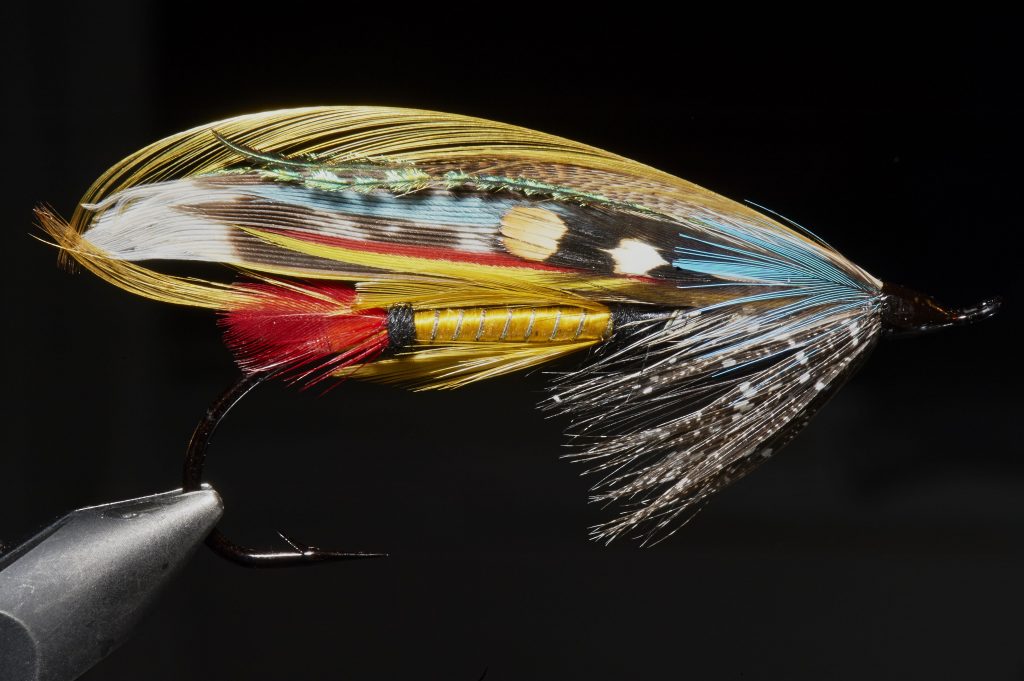
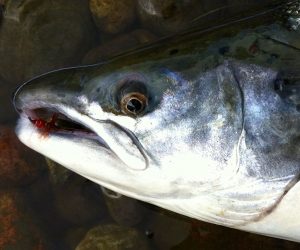
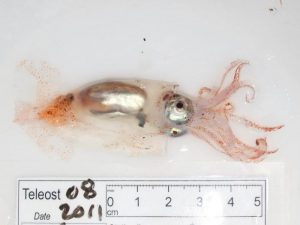
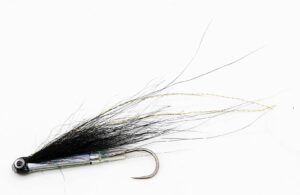
 See our big page on
See our big page on 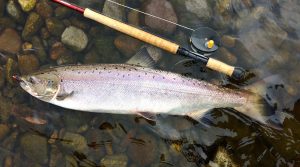 The resident fish
The resident fish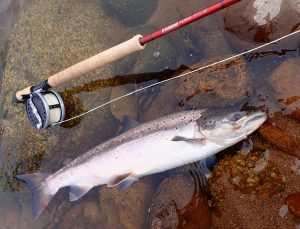
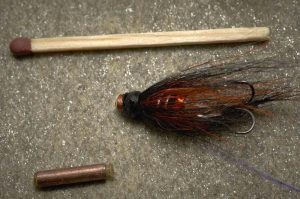
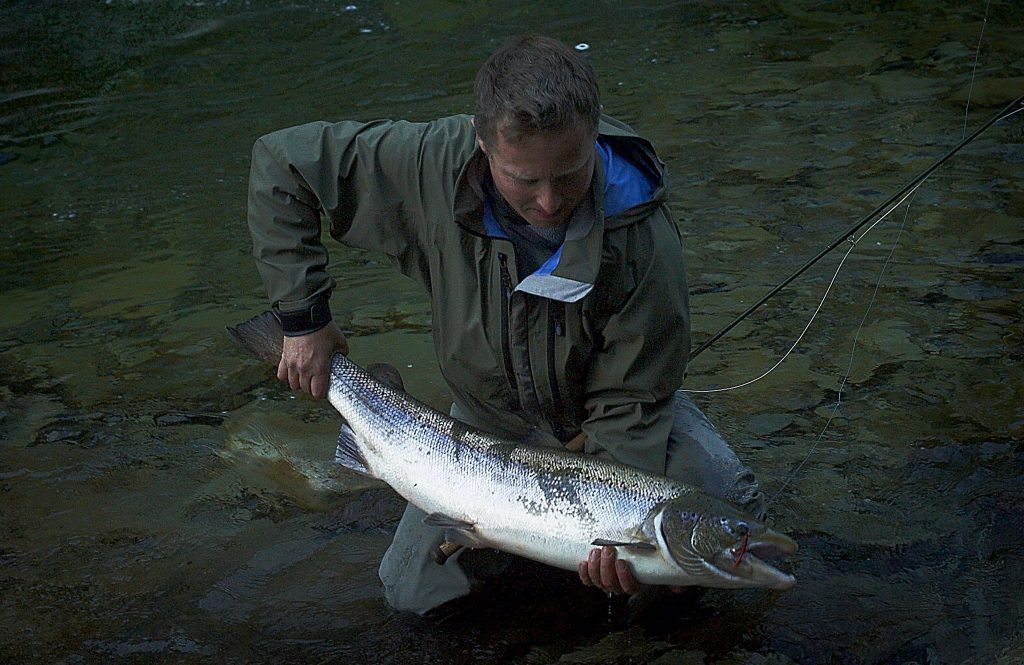
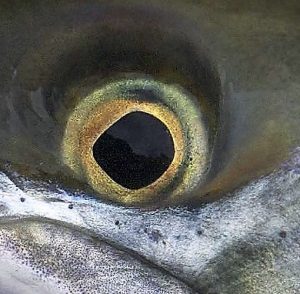

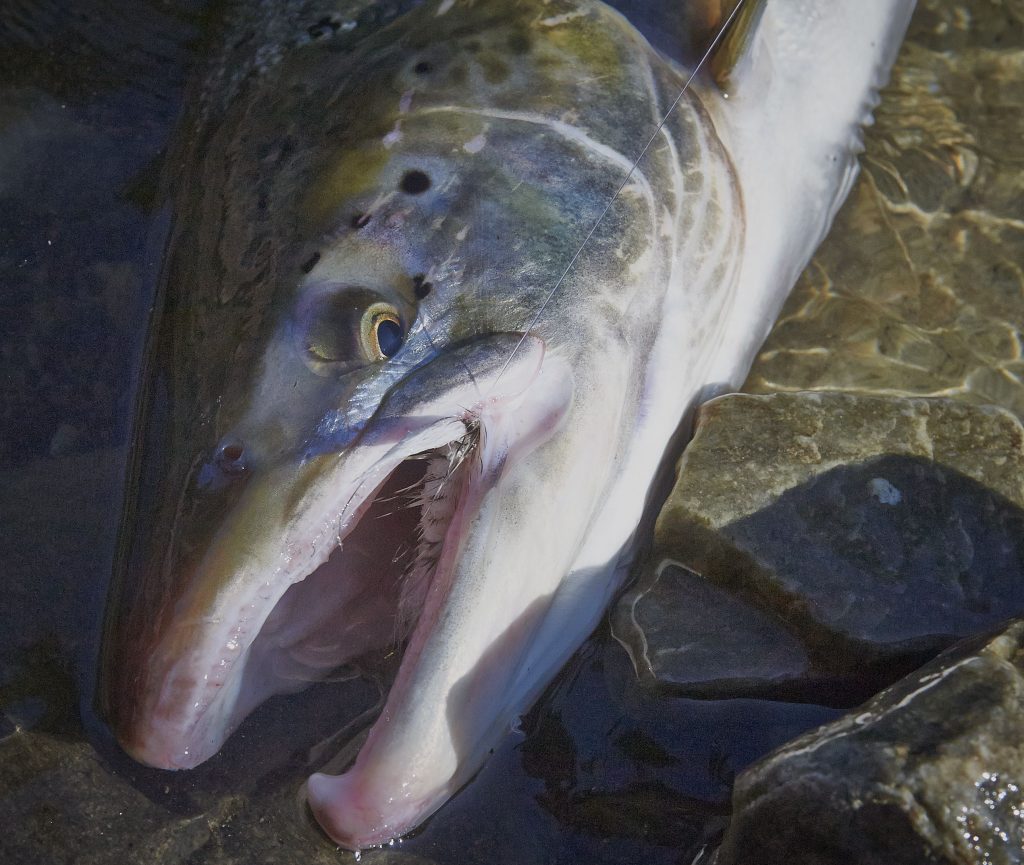

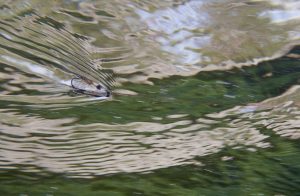 Move your attention to the surface and visit our great page on riffling hitch fishing
Move your attention to the surface and visit our great page on riffling hitch fishing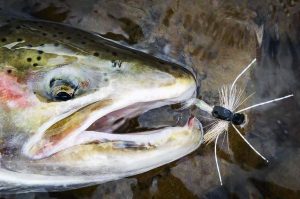 Steelhead and trout fishing in the surface – See our main page on the subject wake fly fishing
Steelhead and trout fishing in the surface – See our main page on the subject wake fly fishing